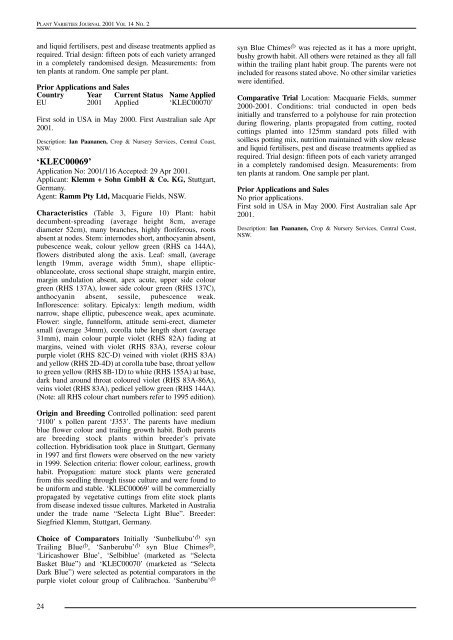47. Volume 14- Number 2 - IP Australia
47. Volume 14- Number 2 - IP Australia
47. Volume 14- Number 2 - IP Australia
Create successful ePaper yourself
Turn your PDF publications into a flip-book with our unique Google optimized e-Paper software.
PLANT VARIETIES JOURNAL 2001 VOL <strong>14</strong> NO. 2<br />
and liquid fertilisers, pest and disease treatments applied as<br />
required. Trial design: fifteen pots of each variety arranged<br />
in a completely randomised design. Measurements: from<br />
ten plants at random. One sample per plant.<br />
Prior Applications and Sales<br />
Country Year Current Status Name Applied<br />
EU 2001 Applied ‘KLEC00070’<br />
First sold in USA in May 2000. First <strong>Australia</strong>n sale Apr<br />
2001.<br />
Description: Ian Paananen, Crop & Nursery Services, Central Coast,<br />
NSW.<br />
‘KLEC00069’<br />
Application No: 2001/116 Accepted: 29 Apr 2001.<br />
Applicant: Klemm + Sohn GmbH & Co. KG, Stuttgart,<br />
Germany.<br />
Agent: Ramm Pty Ltd, Macquarie Fields, NSW.<br />
Characteristics (Table 3, Figure 10) Plant: habit<br />
decumbent-spreading (average height 8cm, average<br />
diameter 52cm), many branches, highly floriferous, roots<br />
absent at nodes. Stem: internodes short, anthocyanin absent,<br />
pubescence weak, colour yellow green (RHS ca <strong>14</strong>4A),<br />
flowers distributed along the axis. Leaf: small, (average<br />
length 19mm, average width 5mm), shape ellipticoblanceolate,<br />
cross sectional shape straight, margin entire,<br />
margin undulation absent, apex acute, upper side colour<br />
green (RHS 137A), lower side colour green (RHS 137C),<br />
anthocyanin absent, sessile, pubescence weak.<br />
Inflorescence: solitary. Epicalyx: length medium, width<br />
narrow, shape elliptic, pubescence weak, apex acuminate.<br />
Flower: single, funnelform, attitude semi-erect, diameter<br />
small (average 34mm), corolla tube length short (average<br />
31mm), main colour purple violet (RHS 82A) fading at<br />
margins, veined with violet (RHS 83A), reverse colour<br />
purple violet (RHS 82C-D) veined with violet (RHS 83A)<br />
and yellow (RHS 2D-4D) at corolla tube base, throat yellow<br />
to green yellow (RHS 8B-1D) to white (RHS 155A) at base,<br />
dark band around throat coloured violet (RHS 83A-86A),<br />
veins violet (RHS 83A), pedicel yellow green (RHS <strong>14</strong>4A).<br />
(Note: all RHS colour chart numbers refer to 1995 edition).<br />
Origin and Breeding Controlled pollination: seed parent<br />
‘J100’ x pollen parent ‘J353’. The parents have medium<br />
blue flower colour and trailing growth habit. Both parents<br />
are breeding stock plants within breeder’s private<br />
collection. Hybridisation took place in Stuttgart, Germany<br />
in 1997 and first flowers were observed on the new variety<br />
in 1999. Selection criteria: flower colour, earliness, growth<br />
habit. Propagation: mature stock plants were generated<br />
from this seedling through tissue culture and were found to<br />
be uniform and stable. ‘KLEC00069’ will be commercially<br />
propagated by vegetative cuttings from elite stock plants<br />
from disease indexed tissue cultures. Marketed in <strong>Australia</strong><br />
under the trade name “Selecta Light Blue”. Breeder:<br />
Siegfried Klemm, Stuttgart, Germany.<br />
Choice of Comparators Initially ‘Sunbelkubu’ A syn<br />
Trailing Blue A , ‘Sanberubu’ A syn Blue Chimes A ,<br />
‘Liricashower Blue’, ‘Selbiblue’ (marketed as “Selecta<br />
Basket Blue”) and ‘KLEC00070’ (marketed as “Selecta<br />
Dark Blue”) were selected as potential comparators in the<br />
purple violet colour group of Calibrachoa. ‘Sanberubu’ A<br />
24<br />
syn Blue Chimes A was rejected as it has a more upright,<br />
bushy growth habit. All others were retained as they all fall<br />
within the trailing plant habit group. The parents were not<br />
included for reasons stated above. No other similar varieties<br />
were identified.<br />
Comparative Trial Location: Macquarie Fields, summer<br />
2000-2001. Conditions: trial conducted in open beds<br />
initially and transferred to a polyhouse for rain protection<br />
during flowering, plants propagated from cutting, rooted<br />
cuttings planted into 125mm standard pots filled with<br />
soilless potting mix, nutrition maintained with slow release<br />
and liquid fertilisers, pest and disease treatments applied as<br />
required. Trial design: fifteen pots of each variety arranged<br />
in a completely randomised design. Measurements: from<br />
ten plants at random. One sample per plant.<br />
Prior Applications and Sales<br />
No prior applications.<br />
First sold in USA in May 2000. First <strong>Australia</strong>n sale Apr<br />
2001.<br />
Description: Ian Paananen, Crop & Nursery Services, Central Coast,<br />
NSW.

















